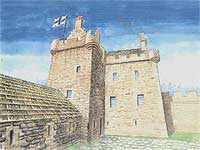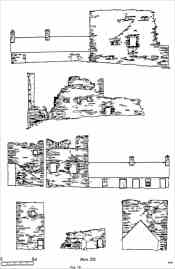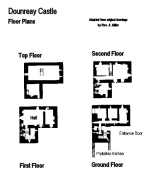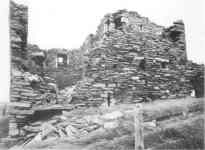Dounreay Castle, Caithness
Map Ref: ND 983670
Dounreay Castle Photo Gallery
Dounreay Castle
H. Gordon Slade
 This small L house is a scaled down version of a type
more usually associated with N.E. Scotland. Now entirely ruined it was
still inhabited in 1863, but had become derelict and roofless by 1889.
It was in existence in 1614, the property of William Sinclair of
Dunbeath, and the surviving details accord with a building date in the
last quarter of the sixteenth century.
This small L house is a scaled down version of a type
more usually associated with N.E. Scotland. Now entirely ruined it was
still inhabited in 1863, but had become derelict and roofless by 1889.
It was in existence in 1614, the property of William Sinclair of
Dunbeath, and the surviving details accord with a building date in the
last quarter of the sixteenth century.
 It was of
three floors with the principal apartments in the long arm of the L,
the shorter arm containing the staircases, and an additional chamber.
There was additional garret accommodation with freestone dressings,
which have weathered very badly. It appears to have had very full lime
pointing but there is little or no evidence to suggest that it was ever
harled.
It was of
three floors with the principal apartments in the long arm of the L,
the shorter arm containing the staircases, and an additional chamber.
There was additional garret accommodation with freestone dressings,
which have weathered very badly. It appears to have had very full lime
pointing but there is little or no evidence to suggest that it was ever
harled.
Externally most of the
openings have chamfered heads, jambs and cills, and some of the larger
windows have relieving arches above their flat lintels. Most of the
windows originally had bars. On the upper floors are three re-used
pieces of dressed freestone with ventilation holes cut in them. These
would have admitted air to the night stool closets. There are three
apparent shotholes of a very simple nature; one set obliquely at the
foot of the staircase covers the entrance in the re-entrant; the others
are on the N front, but one of them could be a much weathered slop
drain or water intake.
 At the NE corner of the main block
is the toothing of the barmekin wall, and to the S of the stair tower
is a further stretch of barmekin wall forming the rear wall of a range
of pentice buildings. Amongst these would have been the kitchen, as
there is no sign of one within the main house.
At the NE corner of the main block
is the toothing of the barmekin wall, and to the S of the stair tower
is a further stretch of barmekin wall forming the rear wall of a range
of pentice buildings. Amongst these would have been the kitchen, as
there is no sign of one within the main house.
Immediately facing the
entrance is a small barrel-vaulted lobby opening off which are two
small closets and the cellar passage, all three doors having chamfered
heads and jambs. In MacGibbon and Ross (Vol. III, p.630) the ground
floor of the main block is shown divided into three cellars with a
short access passage on the S side. This standard arrangement
presumably survives under the tumble which fills this floor. The
cellars were not vaulted except for the passage, which was roofed with
stone flags. This provided a fire proof surface in front of the Hall
fire-place which was in the S wall on the floor above.
 To the left of the entrance - with its draw bar slots -
access to the first floor was by way of a straight two-flight stone
stair, the whole stair hall being covered by a barrel-vault, and lit by
a window, now blocked, looking across the pentice roof. The space
between the top of the stairs and the wall above the entrance is now a
void but originally it would have been floored over. From the creasing
in the wall it is clear that this flooring would have been stone slabs.
This would have given access to the loop above the entrance. This loop
shows a particularity seen elsewhere in Dounreay - an aumbry below a
loop, with a deep stone shelf between the two. This of course is made
possible by the nature of the stone which is easily formed into slabs.
To the left of the entrance - with its draw bar slots -
access to the first floor was by way of a straight two-flight stone
stair, the whole stair hall being covered by a barrel-vault, and lit by
a window, now blocked, looking across the pentice roof. The space
between the top of the stairs and the wall above the entrance is now a
void but originally it would have been floored over. From the creasing
in the wall it is clear that this flooring would have been stone slabs.
This would have given access to the loop above the entrance. This loop
shows a particularity seen elsewhere in Dounreay - an aumbry below a
loop, with a deep stone shelf between the two. This of course is made
possible by the nature of the stone which is easily formed into slabs.
The first floor of the
main block is divided, as is customary in smaller houses in the N.E.
into two rooms, the Hall and the Inner Chamber. At Dounreay, however,
there is no access from the Inner Chamber to an upper chamber, so it is
safe to say that this Inner Chamber combined the functions of
Withdrawing Room, Laird's Room, and Bed Chamber. The provision of a
draw bar hole for the doorway between the stair head and the Hall shows
that this floor was designed as a self-contained suite.
Immediately within the
Hall door, in the W wall, is a small pantry closet, and in the section
of the W wall that has disappeared there may have been a further closet
for a closed stool. The S wall contains the fire place: this has been
contracted at some time, but as originally built it was a wide opening
with the normal late sixteenth century roll mould to the head and
jambs. The stone apron, formed by the slabbed ceiling of the cellar
passage which ran along the S side of the Hall protected the timber
floor from the risk of fire. The ceiling of the Hall, which was in fact
the floor of the rooms above, was carried on heavy beams spanning N-S
and set directly into the walls. However, to give some further
architectural interest, into this wall a length of moulded stone in the
form of a continuous corbel has been introduced immediately above the
fireplace. This also ensured that the beams at this point were not set
too deeply into the wall of the flue. In the E jamb of the window in
the S wall there are the remains of an aumbry, and there may well have
been a salt box in the W jamb against the side of the fireplace.
The doorway to the Inner
Chambers is in the NE corner of the Hall. Like the Hall this chamber
has a large fireplace, later contracted, with roll mould head and
jambs. In the N wall is the night stool closet, and in the NE corner is
a blocked window. There is a press in the SE corner with the remains of
two aumbries, and the window in the S wall has two more aumbries, the
one in the W jamb being checked to take a door. Presumably this was a
secure place to store the charters and muniments.
Both these rooms were plastered on the
hard.
From the stair landing a
semi-circular mural stair gives access to the upper floor. There is a
small chamber in the stair tower which acts as a lobby to the rooms in
the main block at this level. There seem to have been two chambers on
this floor with fireplaces in the E and W gables. Only that in the E
gable survives, and then in a very decayed condition. It seems to have
had the usual roll mould. The cross wall on the first floor did not
rise through to the second floor so it would seem that the partition at
this level was of timber with plaster infill. Later alterations and
collapse have obscured the arrangements of the closets which would have
served these chambers. A further mural stair led up to the cock-loft
over the stair tower, but it would seem that as originally built the
chambers on the second floor were either open to the roof, or only had
storage-lofts above them.
Although Dounreay is not a
large house its arrangements are well thought out and the planning is
as advanced as any to be found further south, and internally it aims at
some architectural distinction. Externally, however, it makes no
pretensions, and no attempt is made to embellish it with elaborate
upper works or dignify it with heraldic devices. It is an entirely
seemly building, and suitable to its setting.
Acknowledgement: This article is reprinted with the permission of R. J.
Mercer from Volume II of Edinburgh University's Archaeological Field
Survey in Northern Scotland.
This Article Appeared in
Caithness field Club Bulletin April 1988